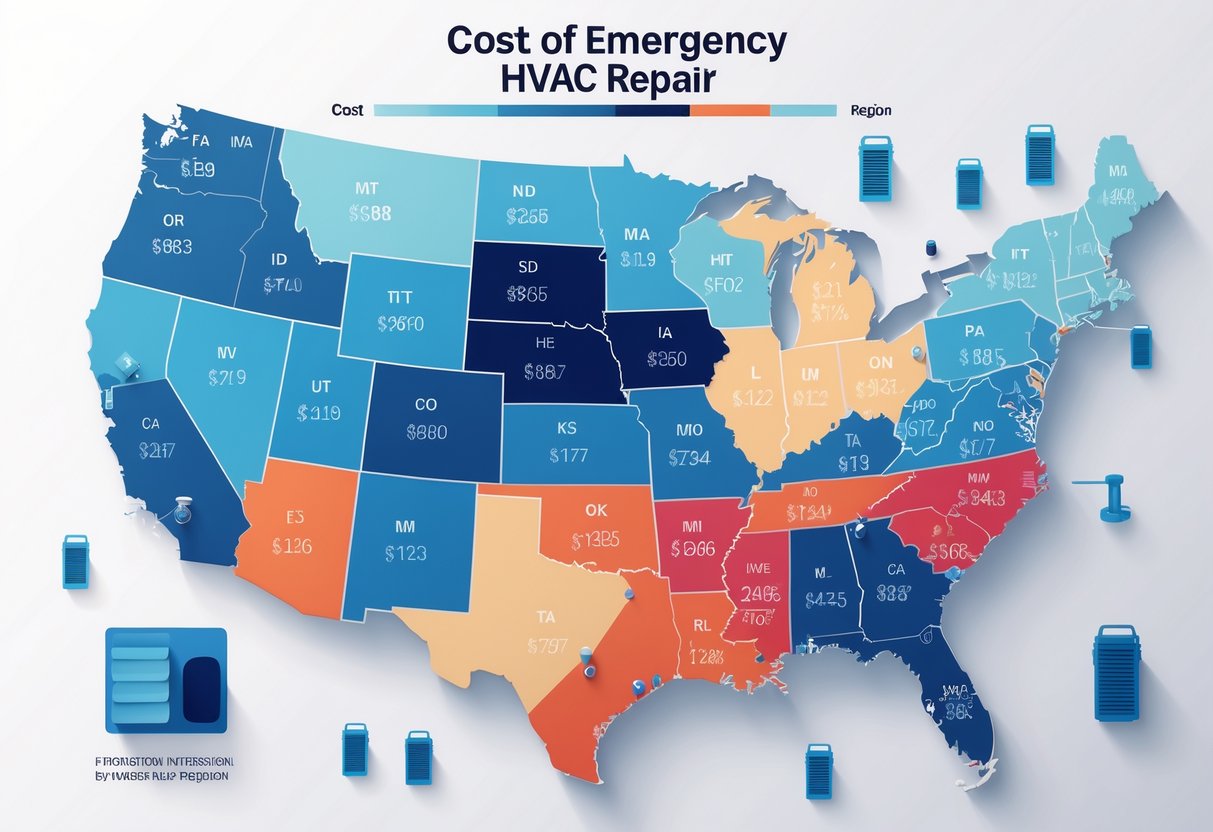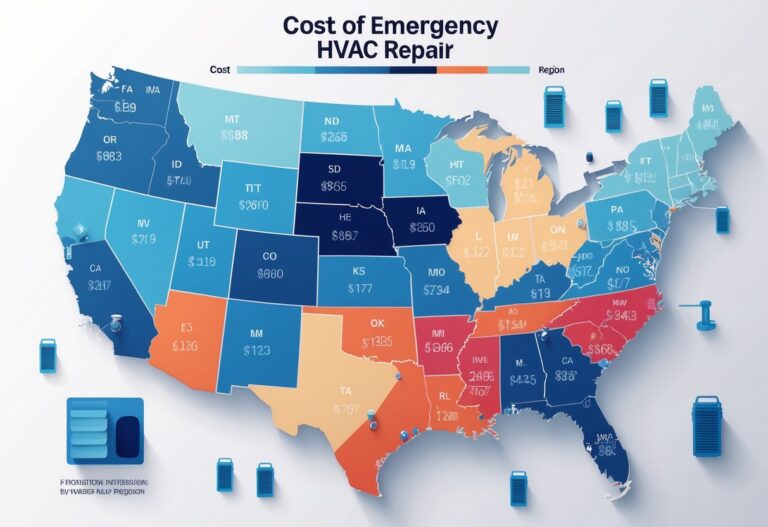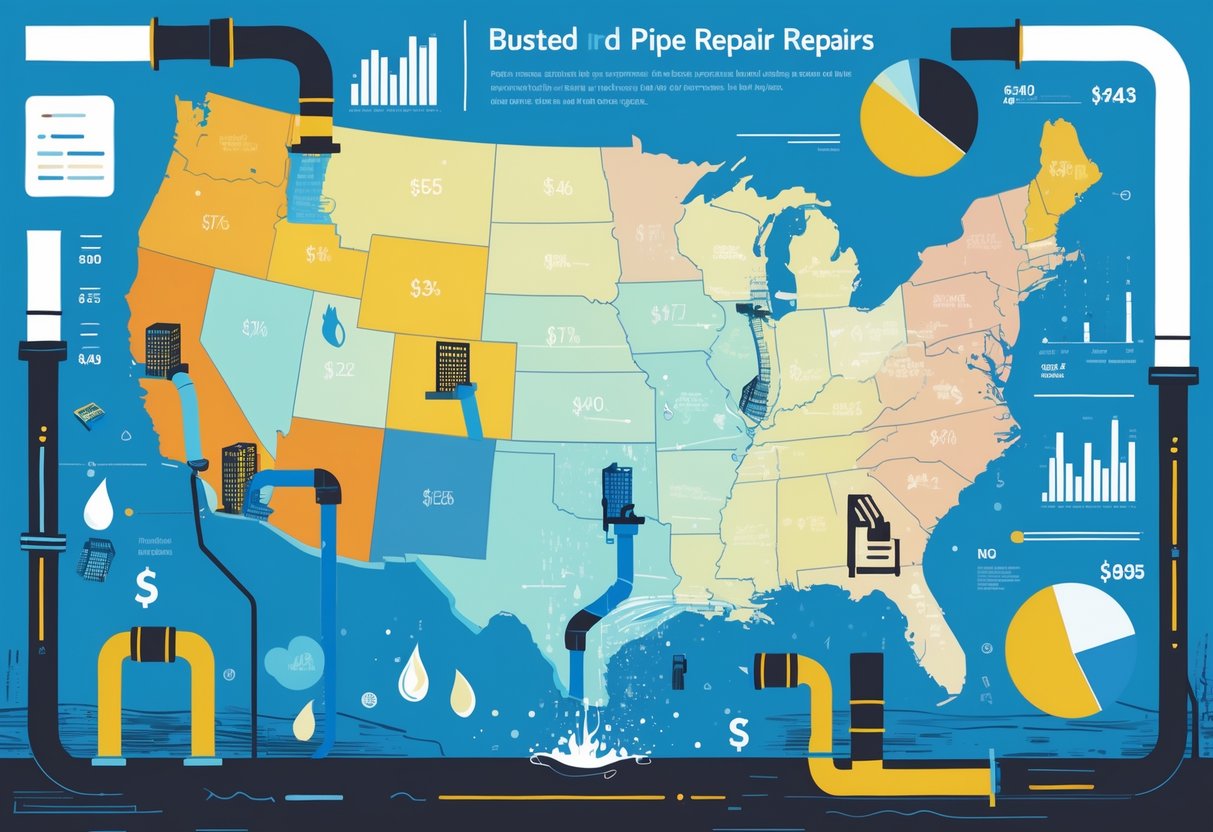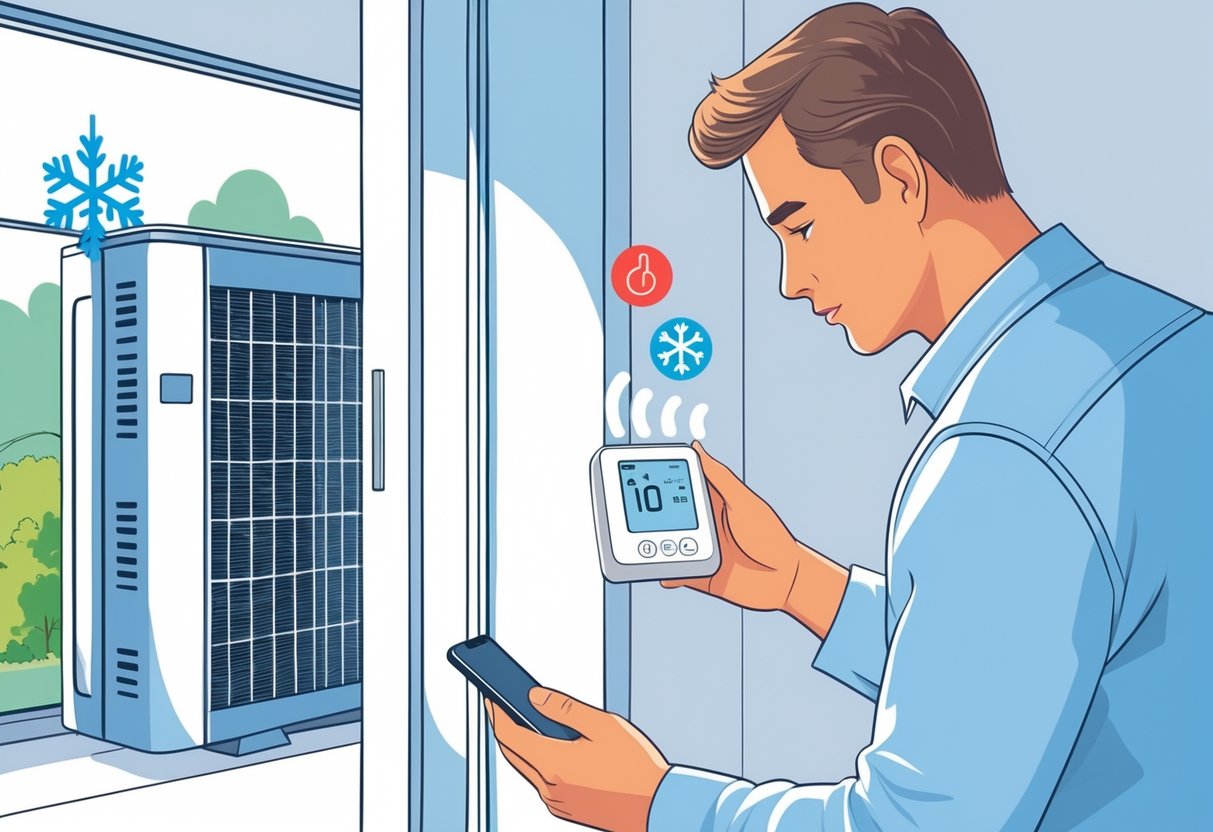When your HVAC system suddenly quits during a heatwave or a deep freeze, you need emergency repairs—and fast. What you’ll pay for that urgent fix? Well, that depends a lot on where you live.

On average, emergency HVAC repairs cost between $300 and $400 nationwide. But the range is wide—anywhere from $150 to $500 for those after-hours calls, all depending on your zip code.
Big cities and pricey regions usually charge more than smaller towns. The final bill also depends on how tricky the repair is, whether special parts are needed, and what season it is.
This guide takes a close look at emergency repair costs by region. We’ll dig into what drives those price swings and toss in a few tips to help you handle these sudden, expensive repairs when your system dies at the worst moment.
Need a Home Fix – Emergency or Routine?
From leaks and no-heat nights to simple tune-ups, our 24/7 hotline connects you with trusted local pros in minutes.
Key Takeaways
- Emergency HVAC repair costs swing a lot by region—urban areas often charge 20-40% more than rural places.
- After-hours fees and peak summer or winter demand can double what you’d pay for a regular repair.
- Preventive maintenance, service contracts, and shopping around for quotes can help keep emergency expenses down.
Regional Variations in Emergency HVAC Repair Costs
Emergency HVAC repair costs aren’t remotely the same everywhere. The Northeast and West Coast? They’re typically 20-40% pricier than the South or Midwest.
Labor shortages, crazy climate swings, and local rules all play a part in these regional price differences.
Northeast Cost Factors
The Northeast is notorious for the highest emergency HVAC repair bills in the country. Just getting a tech to your door can run $200-$400.
Labor is the big culprit. Technicians in cities like New York or Boston charge $120-$180 an hour. That’s a hefty jump compared to elsewhere.
There are also extra hoops to jump through—regulations mean more certifications and permits, which drive up costs.
Winter hits hard here. When the cold snaps, heating systems get slammed, and repairs during these times often come with overtime rates and sometimes special equipment needs.
Everything’s more expensive in the Northeast, honestly. HVAC companies have to pay top dollar to keep good techs, and those costs get passed on to you.
Midwest Pricing Trends
The Midwest tends to be a little easier on the wallet. Emergency service calls usually cost $150-$275 for the initial visit.
Labor rates? They average $85-$130 per hour. Smaller towns see lower rates, but big cities like Chicago still charge a premium.
Prices jump in the summer and winter when everyone’s AC or heat is on the fritz. If you need help in spring or fall, you might catch a break.
Parts are usually easier to get in the Midwest, which helps keep costs from ballooning.
Competition varies—a big city might have a handful of HVAC companies fighting for your business, but in a small town, you might only have one or two choices, and that can push prices up.
Southern Market Rates
The South is generally more affordable for emergency HVAC repairs. Most initial service calls will set you back $125-$250.
It’s all about the AC here. When the summer heat is brutal, emergency repairs for cooling systems can range from $200 to $800, depending on what’s gone wrong.
Labor is cheaper—techs often charge $75-$120 per hour. That keeps things a little more manageable for most folks.
Hurricane season is a wild card. Big storms can wreck thousands of HVAC units at once, and after a major storm, prices can spike just from demand.
Air conditioners work overtime here—sometimes 8-10 months a year. That extra use means more breakdowns, plain and simple.
Western Region Differences
The West is a mixed bag when it comes to emergency HVAC costs. If you’re in coastal California, brace yourself for some of the highest rates in the country.
In places like LA or San Francisco, just the emergency call can start at $250-$450. Hourly labor? Sometimes $150-$200.
California’s strict environmental rules mean repairs are more complicated and require certified techs and special equipment. That all adds up.
Desert states like Arizona and Nevada have their own challenges. Extreme heat means ACs are pushed to their limits, and repairs—especially during a heatwave—can come with hazard pay.
And let’s not forget the tech shortage. It’s tough to find enough skilled workers, so companies pay more, and so do you.
Key Factors Affecting Emergency HVAC Repair Prices
So what really drives the price when your HVAC system goes down? Labor rates are a big one—local wages and tech availability matter a lot. Older systems also tend to need pricier parts and more complicated repairs.
Labor and Technician Rates
Emergency calls are always more expensive than regular appointments. Most techs charge $75 to $150 an hour during normal hours.
Call after hours? Expect to pay 50% to 100% more. Weekends and holidays? That’s when you’ll really feel the sting.
Rates vary a ton by region. In big cities like New York or San Francisco, you could be looking at $125-$200 an hour. In the countryside, maybe $60-$100.
Emergency service fees often include:
- Diagnostic charges ($75-$150)
- Trip charges ($50-$100)
- After-hours surcharges ($100-$200)
Certification matters too. Master techs with specialized training charge more. If refrigerant is involved, you’ll need a licensed pro, which bumps up the price.
HVAC System Age and Condition
Old HVAC systems are a pain when they break. Repairs can be 25% higher for systems older than a decade.
Finding parts for old units can be tricky. Sometimes you’re paying for special orders or even custom fabrication, which sends costs through the roof.
Age-related costs include:
- Extra time to figure out what’s wrong
- More parts failing at once
- Need for special tools
- Usually no warranty left on older parts
If you haven’t kept up with maintenance, expect more problems at once. Neglect can turn a simple fix into a much bigger, more expensive job.
Severity of Malfunction
Quick fixes like swapping out a capacitor might cost $150-$300. If it’s something major, like a compressor, you’re looking at $1,500 or more for an emergency repair.
Full system breakdowns mean long diagnostics and usually several parts to replace. Compressor failures are the worst—$1,000 to $3,000 isn’t unusual, labor included.
Common emergency repair costs:
- Thermostat issues: $200-$400
- Blower motor failure: $300-$600
- Refrigerant leaks: $400-$800
- Electrical problems: $250-$700
If there’s a safety risk—like gas leaks, electrical dangers, or carbon monoxide—you can’t wait, no matter the price. Those situations often mean calling in other pros and paying for more labor hours.
Breakdown of Common Emergency HVAC Repairs and Costs
Emergency HVAC repairs usually run anywhere from $150 to $1,500, all depending on what broke and what parts are needed. The big-ticket items? Stuff like compressor replacements. Mid-range? Refrigerant leaks and thermostat problems.
Compressor Replacement Expenses
The compressor is the heart of your HVAC. If it dies, you’re in for one of the priciest repairs—usually $1,200 to $3,000 for a home unit.
Labor alone can be $500 to $800. And if it’s an emergency, expect those rates to be two or three times higher than normal.
Here’s how the bill breaks down:
- Compressor: $700-$2,200
- Labor: $500-$800
- Emergency fee: $150-$300
Older systems often need a full compressor swap instead of a repair. If your unit’s over 10 years old, you might end up replacing a few other parts too.
Where you live matters. Big cities like New York or San Francisco often charge 20-30% more than rural spots.
Refrigerant Leak Repair Pricing
Refrigerant leaks are a headache—and they need quick attention. Repairs range from $200 to $800, depending on where the leak is and how bad it is.
If it’s just a seal, maybe $200 to $350. If it’s the evaporator coil, you could pay $500 to $800 for an emergency fix.
Typical refrigerant leak costs:
- Finding the leak: $100-$200
- Minor seal repair: $150-$250
- Refilling refrigerant: $100-$300
- Emergency premium: $75-$150
R-410A refrigerant usually costs $50 to $80 a pound in a pinch. The old R-22? That can be $100 to $150 a pound since it’s being phased out.
Anytime there’s a leak, you’ll need a refill—otherwise, your system just can’t keep up.
Heat Exchanger Repair or Replacement
Heat exchanger problems are no joke—they can be downright dangerous and need a pro ASAP. Emergency repairs usually run between $500 and $2,500.
If you catch a minor crack early, repairs might only cost $500 to $800. But a full replacement during an emergency? That’ll set you back $1,500 to $2,500.
Heat exchanger service costs:
- Inspection and testing: $150-$250
- Minor repairs: $300-$500
- Complete replacement: $1,200-$2,000
- Emergency labor premium: $200-$500
Sometimes, heat exchanger failures are a sign your whole system’s in trouble. If your furnace is over 15 years old, replacement is often the only real fix.
Carbon monoxide testing tacks on another $50 to $100 for emergency calls. Safety shutoffs keep families safe but can leave you without heat in a hurry.
Smart Thermostat Issues
Smart thermostats bring their own headaches, especially in emergencies. Most repairs fall in the $150 to $400 range.
About 40% of emergency calls are for connectivity issues. The rest? Power supply failures and software bugs, mostly.
Smart thermostat repair costs:
- Diagnostic service: $75-$150
- Software troubleshooting: $100-$200
- Wiring repairs: $150-$300
- Emergency service fee: $100-$200
If your HVAC system is on the older side, getting it to play nice with a smart thermostat may mean extra wiring work. C-wire installation can add $150 to $250.
Honestly, a lot of smart thermostat problems boil down to bad setup. Professional reconfiguration during emergencies usually costs $100 to $200.
Service Fee Structures and After-Hours Charges
Emergency HVAC companies have all kinds of pricing models, and they can make your bill jump fast. Most tack on emergency call-out fees from $100 to $400, plus either hourly rates with overtime or flat after-hours fees.
Emergency Call-out Fees
These fees are just for getting a tech out to you after hours. They don’t cover actual repairs or parts.
Standard emergency fees range from $100 to $400 depending on where you live and which company you call. Usually, this covers:
- Travel time
- Initial diagnosis
- Basic troubleshooting
Some companies will drop the call-out fee if you go ahead with a big repair. Others just credit it toward your bill.
Urban areas? Expect $200 to $400 for emergency calls. Rural spots might charge $100 to $250, but you could be waiting longer for help.
Most places want that emergency fee up front, whether they fix your system or not. It’s how they keep the lights on for 24/7 service.
Hourly Versus Flat Rate Billing
There are two main ways companies bill for emergency repairs, and they definitely affect your wallet.
Hourly billing is $75 to $150 per hour during regular hours. For emergencies, rates double or triple—think $150 to $275 an hour.
Overtime charges kick in for:
- Evenings (after 6 PM)
- Weekends
- Holidays
Flat rate billing means you pay a set price for specific repairs, no matter how long it takes. It’s predictable, but sometimes pricier for quick fixes.
| Billing Method | Regular Hours | Emergency Hours |
|---|---|---|
| Hourly Rate | $75-$150/hour | $150-$275/hour |
| Flat Rate | Fixed price | 1.5x-2x regular rate |
Membership programs can knock down those emergency hourly rates. Usually, they cost $150 to $300 a year and bump you up the priority list.
Premium Charges for Holidays and Weekends
Need help on a weekend or holiday? Brace yourself—these are the priciest times for HVAC calls.
Weekend rates often add 50% to 100% to standard emergency fees. So a $200 call can turn into $300 or $400 real quick.
Holiday premiums are even steeper, jumping 150% to 200% above the norm. Christmas, New Year’s, and Thanksgiving are the worst offenders.
Typical holiday surcharge schedule:
- Minor holidays: 25% to 50% premium
- Major holidays: 100% to 150% premium
- Christmas/New Year: Up to 200% premium
Weirdly, Sunday calls sometimes cost less than Saturdays. Some companies even treat Sunday like a regular workday.
If you need emergency HVAC repair during a holiday heat wave or cold snap, expect sky-high prices. That’s just how it goes.
How Seasonal Demand Influences Emergency Repair Prices
Emergency HVAC repair prices shoot up when systems are working their hardest. Summer and winter are rough—everyone needs help at once, so rates spike.
Peak Summer Cooling Repairs
When it’s blazing outside, air conditioners break left and right. Emergency calls can jump by 123% in the South during peak summer months.
Why rates climb in summer:
- More demand, longer waits
- After-hours premiums
- Parts are harder to find—and pricier
- Units fail when they’re pushed to the max
Emergency call-out fees are $100 to $400 on top of regular repair charges. A busted coil in July? That could run $3,000 to $6,000, believe it or not.
Parts get more expensive in the summer, too. Scarcity drives up the price just like labor.
Southern states see the wildest price swings—almost half of all HVAC problems happen in just three months of summer.
Winter Heating Emergencies
When the furnace gives out in winter, it’s a real emergency. February is the second priciest month for HVAC fixes, with bills averaging 15% higher.
Winter emergencies are tough because:
- Furnaces break during cold snaps
- Pipes can freeze and cause more damage
- Fewer techs are available
- Some places have laws for quick repairs
Northern states see a 61% jump in repair requests during winter. The cold makes everything more urgent—and expensive.
Heating repairs can’t wait. Dangerous conditions mean you need a pro, fast.
Tips to Reduce Emergency HVAC Repair Expenses
Want to avoid blowing your budget on surprise repairs? Smart maintenance and planning go a long way. Having a little cash stashed and picking the right pros helps, too.
Regular HVAC Maintenance
Maintenance is the best way to dodge emergencies and keep your system humming. Change those air filters every 1-3 months—seriously, it matters.
Dirty filters are behind 80% of HVAC breakdowns. Clean filters mean better airflow and less stress on your system.
Get a pro tune-up every year. They’ll check refrigerant, clean coils, and test electrical stuff you probably don’t want to mess with.
Don’t skip these tasks:
- Clear debris from outdoor units
- Double-check thermostat settings
- Look for duct leaks
- Test safety controls
Take a look around each month—listen for weird noises or sniff for odd smells. If your system isn’t heating or cooling like it used to, don’t ignore it.
Annual maintenance runs $100-300, but it saves you from repairs that can cost thousands. Preventive care really is cheaper in the long run.
Budgeting for Sudden Repairs
Emergency repairs cost way more than regular service calls. Having a repair fund helps you avoid panic when something breaks.
Experts say to save $100-200 a month for home repairs. HVAC issues make up about 20% of surprise service calls, so it’s worth planning for.
Budget tips:
- Set aside 1-3% of your home’s value yearly
- Use a high-yield savings account
- Look into home warranties
- Check out financing options before you need them
Home warranties cost $400-800 a year and cover the big stuff. They can really cut down your out-of-pocket costs when things go sideways.
Some utility companies offer maintenance plans with cheaper repairs and priority service. Not a bad deal if you want peace of mind.
Choosing Qualified HVAC Professionals
Don’t just hire anyone—licensed pros get it right the first time. Always check credentials with your state licensing board.
Look for these qualifications:
- Valid state license
- Liability insurance
- Manufacturer certifications
- Local references
For non-emergencies, get a few quotes so you know what’s fair. That way, you’re not blindsided during an emergency.
Local companies usually offer better service than out-of-towners. They’re invested in their reputation and community.
Emergency HVAC work costs more up front, but it’s worth it to avoid future headaches. Unlicensed repairs can end up costing double if you have to fix them later.
Reputable companies offer 24/7 service and clear pricing. Always ask about after-hours rates and minimum charges before you agree to anything.
Frequently Asked Questions
Emergency HVAC repairs can run from $150 to $1,500, depending on where you live. Big cities usually charge 20-40% more than rural areas, and seasonal demand plus local labor costs make a big difference in what you’ll pay.
How do HVAC emergency repair costs vary by region in the U.S.?
HVAC emergency repair costs really do swing quite a bit depending on where you are in the U.S. The Northeast and West Coast? Those spots usually hit you with the highest rates, mostly thanks to the pricier cost of living and tighter regulations.
Down South, prices tend to land somewhere in the middle. The Midwest, on the other hand, is known for more competitive rates.
Mountain states? They’re kind of in that in-between zone. Urban areas almost always tack on an extra 15-25% compared to the nearby rural towns.
Just the emergency service fee alone might be as low as $75 in rural spots, but in big cities, don’t be shocked if it’s closer to $200.
What factors influence the regional differences in HVAC repair expenses?
Local labor costs are usually the biggest reason prices jump around. If you’re in an area with higher minimum wages or strong unions, expect to pay more for service.
Living expenses—like pricey rent and utilities—push up technician wages and business overhead. Those costs get passed right along to customers.
Some places have stricter regulations and licensing requirements. More certifications mean more business expenses, which, again, show up on your bill.
Parts can be a pain, too. If you’re out in the sticks, shipping costs bump up the price and sometimes even slow down the repair.
What is the typical price range for emergency HVAC services in major U.S. metropolitan areas?
In New York City or San Francisco, emergency HVAC repairs usually fall somewhere between $200 and $2,000 per service call. Los Angeles and Washington D.C. aren’t far behind, with similar numbers.
Chicago and Boston? You’re generally looking at $175 to $1,800 for emergency work. These cities always seem to need more skilled techs, no matter the season.
Atlanta and Dallas offer a bit of relief, with most emergency repairs ranging from $150 to $1,500. Phoenix and Miami hover in that ballpark, even with their wild weather.
Hourly emergency rates in these big cities? They can run from $135 up to $250 an hour. And don’t forget—service call fees usually tack on another $75 to $150.
How does the cost of emergency HVAC repair in rural areas compare to urban centers?
Rural repairs typically come in 20-35% cheaper on labor than what you’d pay in the city. But, here’s the twist: if parts are hard to get, that savings can disappear fast.
Techs in rural areas often cover a ton of ground, so you might get hit with travel charges—sometimes an extra $50 to $100 for those long drives.
There’s usually not a ton of emergency providers out in the country, which can limit competition. Funny enough, that sometimes cancels out the cheaper labor.
Waiting longer for service is pretty common, too. And if you need help on a weekend or holiday, those emergency premiums can double—sometimes even more.
Can regional climate influence the cost of HVAC emergency repairs?
Absolutely, climate can crank up repair costs. In places like Arizona or Nevada, the brutal summer heat leads to more compressor failures and higher bills.
Northern states with those freezing winters? Emergency heating repairs there, like in Minnesota or North Dakota, often cost 15-20% above the national average.
Coastal areas get their own headaches. High humidity and salty air in spots like Florida or California mean more corrosion, so you might need special parts or extra labor.
If you’re in a region that gets slammed by hurricanes or tornadoes, expect surge pricing during storms. Demand goes through the roof, and so do the rates.
What are the average labor rates for emergency HVAC technicians across different U.S. regions?
Northeast technicians usually charge anywhere from $150 to $250 per hour for emergency services. If you’re in Boston or New York, master-level pros tend to ask for even more—can’t say that’s much of a surprise.
On the West Coast, emergency labor rates range from $140 to $230 per hour. California’s got some strict licensing rules, which definitely bumps up technician pay.
Down South, you’ll generally see rates between $100 and $180 per hour for emergency work. Even with high demand, Texas and Florida markets stay pretty competitive.
Midwest emergency rates are typically around $110 to $190 per hour. In the Mountain states, the average is a bit higher—think $120 to $200 per hour for emergencies.
Holidays and weekends? Expect 50-100% surcharges just about everywhere. After-hours calls often tack on an extra $25 to $75 to whatever the standard hourly rate is.







Leave a Reply